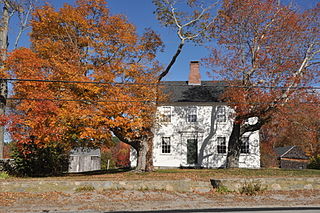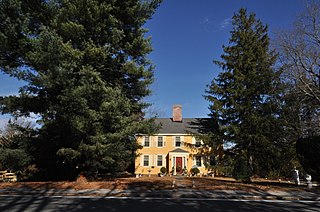
The Clemence–Irons House is a historic house located in Johnston, Rhode Island. It was built by Richard Clemence in 1691 and is a rare surviving example of a "stone ender", a building type first developed in the western part of England and common in colonial Rhode Island. The house is listed on the National Register of Historic Places, and is a historic house museum owned and operated by Historic New England. It is open Saturdays between June and mid-October.

The William Sidney Mount House is a historic house at 1556 Stony Brook Road in Stony Brook, New York. Built in 1725 and enlarged in 1810, it was designated a National Historic Landmark in 1965 as the lifelong home of artist William Sidney Mount (1807–1868). The house is now owned by the Long Island Museum and is occasionally opened for tours.

The William Mowry House is an historic farm house on Farnum Pike in North Smithfield, Rhode Island. It is a 2-1/2 story plank-framed house, five bays wide, with a gable roof and a large central chimney. The main entrance is centered on the main (south-facing) entry, and is enclosed within a single-story hip-roof vestibule of 20th-century construction. A small single-story ell extends to the west of the main block. The interior follows a typical center-chimney plan, with the kitchen and parlor in the front of the house, and the dining room flanked by a small pantry and bathroom in the rear. The house was built c. 1802-05 by William Mowry, whose family has owned land in the area since the 17th century.

The Esek Hopkins House is an historic home on 97 Admiral Street on the north side of Providence, Rhode Island, United States.

The Israel Arnold House is an historic house on Great Road in Lincoln, Rhode Island. It is a 2+1⁄2-story wood-frame structure, set on a hillside lot on the south side of Great Road. The main block is five bays wide, with a central chimney rising through the gable roof. A 1+1⁄2-story gambrel-roofed ell extends to one side. The ell is the oldest portion of the house, built c. 1720 by someone named Olney. The main block was built c. 1760. The house was owned into the 20th century by four generations of individuals named Israel Arnold.

The John Arnold House is an historic house on 99 Providence Street in Woonsocket, Rhode Island. The main block of this two-story wood-frame house is conventionally believed to have been built in 1712, but there is architectural evidence parts of it may be even older. There are two additions: a two-story gable-roof section extending south, to which a mid-20th-century addition has been made. Elements of the house's antiquity remain in the main block despite its conversion to multiunit housing. The house is presumed to have been built by John Arnold, grandson of early Rhode Island settler William Arnold.

The Ballou House is an historic house on Albion Road in Lincoln, Rhode Island, USA. It is a 2½ story wood-frame structure, five bays wide, with a large central chimney. A single-story gable-roof wing extends to the east, and a 20th-century gambrel-roofed ell extends to the north. The house was probably built c. 1782 by Moses Ballou, from one of the first families to settle in the area, and was owned by his descendants through most of the 19th century.

The Bicknell–Armington Lightning Splitter House is a historic house at 3591 Pawtucket Avenue in East Providence, Rhode Island. The house is of a distinctive type, a "Lightning Splitter", of which only a few instances exist in the Providence area. It is a wood-frame structure with a steep two-story gable roof. Records suggest that the house was constructed about 1827, but architectural evidence suggests it was extensively altered in the 1850s. The main entrance and the interior has a simplified Greek Revival styling. The house was listed on the National Register of Historic Places on November 28, 1980.

The Samuel B. Conant House is an historic house in Central Falls, Rhode Island. This 2-1/2 story structure was built in 1895 for Samuel Conant, president of a Pawtucket printing firm, and is one of the city's finest Colonial Revival houses. Its exterior is brick on the first floor and clapboard above, beneath a gambrel roof punctured by several gable dormers. The main facade has two symmetrical round bays, which rise to the roof and are topped by low balustrades. A single-story porch extends between the center points of these bays, and is also topped by a low balustrade.

The Captain George Dorrance House is an historic house in Foster, Rhode Island. It is located on the west side of the road, a short way south of its junctions with Plain Woods Road, not far from the Connecticut border. It is a 2+1⁄2-story wood-frame structure, five bays wide, with a gable roof and a large central chimney. The main block was built c. 1720, and a leanto was added c. 1750. It is one of the best-preserved early 18th-century houses in the state.

The Elliot–Harris–Miner House is an historic house located at 1406 Old Louisquisset Pike in Lincoln, Rhode Island. It is a rambling three-section structure, whose main block is 2-1/2 stories tall with a cross-gable roof with bracketed eaves. The oldest portion of the house, however, was at its rear: it was originally a 1-1/2 story Cape style structure built c. 1710, but this has been torn down and replaced by a garage with a cross-gable roof matching that of the main block. These two sections are joined by a third section with a gable roof. The rear section was believed to be the oldest surviving Cape in Lincoln.

The Maton–Hunt–Farnum Farm is an historic farm on Putnam Pike in Glocester, Rhode Island. The main house is a 2+1⁄2-story wood-frame structure, five bays wide, with a gable roof and a central chimney, and is set on the north side of Putnam Pike. Behind the house are a number of farm outbuildings, including two barns, henhouses, a corn crib, and a privy. Built c. 1793 by Daniel Manton, the house exhibits fine Federal styling both inside and outside.

The Tyler Mowry House is an historic house in North Smithfield, Rhode Island. It is a 2+1⁄2-story wood-frame structure, five bays wide, with a gable roof and two interior chimneys. The entry is centered on the main (south-facing) facade, with sidelight windows and pilasters supporting a complex entablature and cornice. A 1+1⁄2-story ell extends to the east. The interior of the house has retained much of the original Federal-period woodwork, plasterwork, doors, and hardware. The house is distinctive as a remarkably unaltered house from the early 19th century, lacking modernizing alterations such as electricity and plumbing.

The Whipple–Cullen House and Barn is an historic farmstead on Old River Road in Lincoln, Rhode Island. The main house is a 2+1⁄2-story wood-frame structure, five bays wide, with a large central chimney and a gable roof. An addition extends to the rear, and a 19th-century porch is on the side of the house. The barn, dating to the late 19th century, is north of the house, and there is a former farm shed, now converted to a garage, to its south. The property is located across the street from the Lincoln town offices. The house, built c. 1740, is one of the town's least-altered 18th century houses, and the barn is a rare survivor of the town's agrarian past.

The Blackstone Boulevard Realty Plat Historic District is a historic district roughly bounded by Blackstone Blvd., Rochambeau Ave., Holly St. and Elmgrove Ave. in Providence, Rhode Island.

The Edward Dexter House is a historic house in the College Hill neighborhood of Providence, Rhode Island. It is a 2+1⁄2-story wood-frame structure, built in 1795–1797, with a hip roof topped by a square monitor. Its main facade is five bays wide, with the center bay flanked by two-story pilasters and topped by a small gable pediment. The well-preserved interior provided a template for an early-20th-century museum space designed by the Rhode Island School of Design to house a furniture collection donated by the house's then-owner, Charles Pendleton. The house is one of the few 18th-century houses in the city's College Hill neighborhood. It was originally located at the corner of George and Prospect Streets; in 1860 it was sawed in half and moved in sections to its present location.

The Joseph Jeffrey House is an historic house on Old Mill Road in Charlestown, Rhode Island. It is located on the east side of Old Mill Road, just south of Saw Mill Pond and Sawmill Brook, on a predominantly wooded 9.5-acre (3.8 ha) lot. The main house is a 1+1⁄2-story wood-frame structure with a gambrel roof and central chimney, with a small gable-roof ell to the northeast. The oldest portion of the main block appears to be the easterly side, which rests on an old stone foundation, and exhibits construction methods typical of the second quarter of the 18th century. The house was probably built by Joseph Jeffrey, a Narragansett, on land granted to him by the tribe, whose advisory council he sat on.

The Waterman Tavern is a historic house and tavern at 283 Maple Valley Road, near Whaley's Hollow in Coventry, Rhode Island. The 2+1⁄2-story wood-frame house was built before 1747 by John Waterman, who was licensed to operate a tavern on the premises in that year. It is five bays wide with a central chimney. The site was advantageously located on what was then the main road between Providence and Plainfield, Connecticut. The tavern was a center of civic discourse, and town meetings were regularly held there until 1835.

The Kingsley House is a historic First Period house at 108 Davis Street in Rehoboth, Massachusetts in the United States. The oldest portion of this house is estimated to have been built around 1680, making it the oldest structure in Rehoboth. It was listed on the National Register of Historic Places in 1983, where it is listed at 96 Davis Street.

The Caleb Baldwin Tavern is a historic house at 32 Main Street in the Newtown Borough Historic District, located in Newtown, Connecticut, United States. Built c. 1763, the two-and-a-half-story house it is considered historically significant for its role in movement of French forces of Rochambeau, in which the building housed some of the army's officers in June 1781, en route to the Siege of Yorktown. It also an example of traditional 18th-century New England architecture, and retains some details from that time period. It was individually listed on the National Register of Historic Places on August 23, 2002.






















